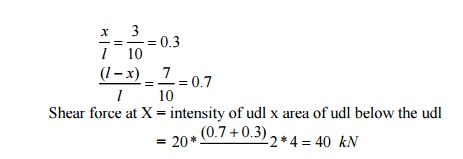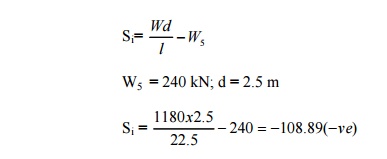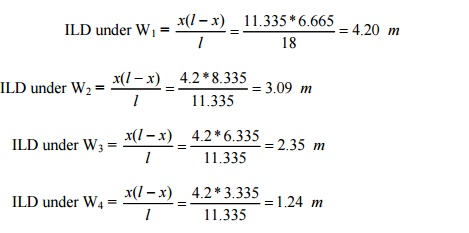Chapter: Civil : Structural Analysis : Influence lines
Influence lines
INFLUENCE LINES
1 Influence lines
An influence line is a
graph showing, for any given beam frame or truss, the variation of any force or
displacement quantity (such as shear force, bending moment, tension,
deflection) for all positions of a moving unit load as it crosses the structure
from one end to the other.
Uses of influence line diagram
(i)
Influence lines are very useful in the
quick determination of reactions, shear force, bending moment or similar
functions at a given section under any given system of moving loads and
(ii)
Influence lines are useful in
determining the load position to cause maximum value of a given function in a
structure on which load positions can vary.
1.A simply supported beam of span 10m
carries a udl of 20 kN/m over its central 4m length. With the help of influence
line diagram, find the shear force at 3m from the left support.

2 Muller -Bresalu principle.
Muller -Bresalu
principle states that, if we want to sketch the influence line for any force
quantity (like thrust, shear, reaction, support moment or bending moment) in a
structure,
(i)
we remove from the structure the
restraint to that force quantity
(ii)
we apply on the remaining structure a
unit displacement corresponding to that forces quantity.
For the two member determine bent in
fig. sketch the influence line for VA.
If we deftly apply
Muller -Breslau to the problem, we can first remove support A and push A up by
unit distance. Since the angle at B will remain unchanged, our unit
displacement will result in a rigid body rotation of ?(=1/4 radian) about C. So
the column CB will also have a horizontal displacement. (For the part AB, the
diagram is just the influence line diagram for shear in a S.S beam)
The diagram for BC must be understood to
be the influence of horizontal loads on the column on RA.
principle on which indirect model
analysis is based
The indirect model analysis is based on the Muller
Bresalu principle.
Muller Breslau
principle has lead to simple method of using models of structures to get the
influence lines for force quantities like bending moments, support moments,
reactions, internal shears, thrusts, etc.
To get the influence
line for any force quantity (i) remove the restraint due to the force, (ii)
apply a unit displacement in the direction of the force.
3.Begg'sformeterde
Begg'sdeformeter is a
device to carry out indirect model analysis on structures. It has the facility
to apply displacement corresponding to moment, shear or thrust at any desired
point in the model. In addition, it provides facility to measure accurately the
consequent displacements all over the model.
'dummy length' modelsin tested with Begg'sformeterde.
Dummy length is the
additional length (of about 10 to 12 mm) left at the extremities of the model
to enable any desired connection to be made with the gauges.
Three types of connections possible with
the model used with
Begg'sformeterde.
(i)
Hinged connection
(ii)
Fixed connection
(iii)
Floating connection
Use of a micrometer
microscope in model analysis with Begg's deformeter
Micrometer microscope
is an instrument used to measure the displacements of any point in the x and y
directions of a model during tests with Begg'seformeterd.
Name the types of
rolling loads for which the absolute maximum bending moment occurs at the mid span
of a beam.
Types of rolling loads:
(i)
Single concentrated load
(ii)
Udl longer than the span
(iii)
Udl shorter than the span
Absolute maximum bending moment in a
beam
When a given load
system moves from one end to the other end of a girder, depending upon the
position of the load, there will be a maximum bending moment for every section.
The maximum of these maximum bending moments will usually occur near or at the
mid span. This maximum of maximum bending moment is called the absolute maximum
bending moment,
Mmaxmax.
The portal frame in
fig. is hinged at D and is on rollers at A. Sketch the influence line for
bending moment at B.
To get the influence
line diagram for MB, we shall introduce a hinge at B (and remove the
resistance to bending moment). Now we get a unit rotation between BA and BC at
B.
BC cannot rotate since
column CD will prevent the rotation. BA would rotate freely (with zero moment).
For ?=1 at B, displacement at A = 3m. The displaced position shows the
influence line for MB as shown in fig.
2.A
single rolling load
of 100 kN
moves on a
girder of span
20m.
(a) Construct the
influence lines for (i) shear force and (ii) bending moment for a section 5m
from the left support. (b) Construct the influence lines for points at which
the maximum shears and maximum bending moment develop. Determine these values.
Solution:
To find maximum shear force and bending moment at 5m
from the left support:
(i) Maximum
positive shear force
By inspection of the
ILD for shear force, it is evident that maximum positive shear force occurs
when the load is placed just to the right of D.
Maximum positive shear force = load * ordinate = 100
* 7.5
At D, SFmax
+ = 75 kN. (ii) Maximum negative shear force
Maximum negative shear force occurs when the load is
placed just to
the left D.
Maximum negative shear
force = load * ordinate = 100 * 0.25 At D, SFmax = -25 kN.
(iii) Maximum bending moment
Maximum bending moment
occurs when the load is placed on the section D itself.
Maximum bending moment = load * ordinate = 100 *
3.75 = 375 kNm
(b)
Maximum positive shear force will occur
at A. Maximum negative shear force will occur at B. Maximum bending moment will
occur at mid span. The ILs are sketched in fig.
(i)
Positive shear force
Maximum positive shear
force occurs when the load is placed at A. Maximum positive shear force = load
* ordinate = 100*1
SFmaxmax + =
100 kN (ii) Negative shear force
Maximum negative shear
force occurs when the load is placed at B. Maximum negative shear force = load
* ordinate = 100 * (-1)
SFmaxmax = -
100 kN (iii) Maximum bending moment
Maximum bending moment
occurs when the load is at mid span Maximum bending moment = load * ordinate =
100 * 5 = 500 kNm
3.Draw the ILD for
shear force and bending moment for a section at 5m from the left hand support
of a simply supported beam, 20m long. Hence, calculate the maximum bending
moment and shear force at the section, due to a uniformly distributed rolling
load of length 8m and intensity 10 kN/m run.(Apr/May 05)
Solution:
(a) Maximum bending moment:
Maximum bending moment
at a D due to a udl shorter than the span occurs when the section divides the
load in the same ratio as it divides the span.

(b) Maximum positive shear force
Maximum positive shear
force occurs when the tail of the UDL is at D as it traverses from left to
right.

(c) Maximum negative shear force
Maximum negative shear
force occurs when the head of the UDL is at D as it traverses from left to
right.
Maximum negative shear
force = Intensity of load * Area of ILD under the load = 10(1/2*0.25*5)
Negative SFmax = 6.25 kN.
4.Two
point loads of 100 kN and 200 kN spaced 3m apart cross a girder of span
15m from
left to right
with the 100
kN load loading.
Draw the influence line for shear force and bending moment and find the
value of maximum shear force and bending moment at a section, 6m from the left
hand support. Also, find the absolute maximum moment due to the given load
system.


5.A train of 5 wheel
loads crosses a simply supported beam of span 22.5 m. Using influence lines,
calculate the maximum positive and negative shear forces at mid span and
absolute maximum bending moment anywhere in the span.
Solution:
(a)
Maximum shear force
(i)
Positive shear force
To determine the load
position to get the maximum positive shear force, let us keep all the loads to
the right of C. Then move W1 load to the left of 'C'by2.5 m. if the
sign of shear increments Si is negative, it will indicate that W1
shall be retained at C

![]() W = Total load on the
span = 120 + 160 +400 + 260 +240 = 1182 kN.
W = Total load on the
span = 120 + 160 +400 + 260 +240 = 1182 kN.
C = Distance through
which the load train is moved = 2.5 m

Since Si is
positive, the shear force increases due to thr shifting of W1 to the
left of C. Again, let us move W2 to the left of C by 2.5 m to check
whether the shera force further increases or not.

Since Si is
negative, it undicates that to get maximum positive shear force, W2
should stay just right of C.

Maximum positive shear force = å(laodxordinate)
= 120 (-0.39) + 160 (0.5) +400 (0.39) +260(0.28) +
240 (0.17)
At C , SFmax
+ = 302.8 kN.
ii) Negative shear force
To determine the
position of loads to get the maximum negative shear force, move the loads one
by one to the right of C and computer the value of Si.If Si
becomes negative it will indicate a decrease in negative shear force due to
that movement.
First let us move the
leading W5 to the right of C by 2.5 m and calculate Si

Since Si is
-ve it indicates that W5 should stay just to the left of C.
Ordinates of ILD:

Maximum negative shear force at C =
240(-0.5)+260(-0.39)+(400(-0.278) +160(-0.167)
+120(-0.056)
Fmax = 366.04 kN.
b)
Absolute maximum bending moment
i)
Position of resultant of all loads
-
Taking moments about W1,
120(0)+160(2.5)+400(5.0)+260(7.5)+240(10.0) =R. x
R = 1180kN
-
x
= 5,72m from W1
ii)
Location of absolute maximum bending
moment
Absolute maximum
bending moment occurs under the load, which is nearest to the resultant
(In'R'thisproblem. W3 is nearest to the resultant 'R').The distance
between C and R and the distance between C and W3 shall be equal.
Distance between R and center of span(C) = ½ (0.72)
=0.36 m
In this fig. Shows the
IL for bending moment at the critical spot D, 10.89 m fro A.
Ordinates of ILD:
Maximum ordinate of ILD

Absolute maximum bending moment =120
(3.04)+160(4.33)+400(5.62)+260(4.41)+ 240 (3.2)
Mmax max = 5220.2 kN.m
6) A girder a span of
18mis simply supported at the ends. It is traversed by a train of loads as
shown in fig. The 50 kN load loading. Find the maximum bending moment which can
occur (i) under the 200 kN load (ii) Under 50 kN load, using influence line
diagrams.
Solution:
a)
Maximum bending moment
i)
Under
200 kN
loads.
To get the maximum
bending moment under W3 the resultant R and W3 should be
at equal distances from the center of the span C.For that the point of action
of resultant R should be determined first.
a) Resultant
of loads:
R = 450 kN
Taking
moments about
W4
200(3) +100 (3+2) +50(3 +2+3) = 450 x
-
x
= 3.33
from W4
b) Bending moment under 200 kN load
Distance between C and
200 kN load = Distance between C and R = 0.33/2 = 0.165 m.
Ordiantes of ILD :

=2.05 m
Bending moment under the 200 kN load
=
200 (4.5) + 100 (2.97) + 100 (3.52) +50
(2.05) = 1651.5 kNm.
(ii)
Bending moment under the load 50 kN
load
To get the maximum
bending moment under W1 , W2 and R must be at equal
distances from the centre of span ©. Distance between C and R = Distance
between C and W1 = ½ (2 -0.33 + 3) = ½ (4.67) = 2.335 m
Ordinates of ILD:

Bending moment under the load 50 kN load
= 4.2 (50) + 3.09 (100) +2.35 (200) +1.24 (100) =
1113 kN m.
6.Draw the I.L for
reaction at B and for the support moment MA at A for the propped
cantilever in fig. Compute the I.L ordinates at 1.5 m intervals.
Solution:
Remove the restraint
due to RB (remove support B) Apply a unit displacement (upward).
When RB = 1, then YXB is the
displacement at section x due to unit load applied at B.

Fig. is the influence line diagram for RB.
To get the I.L for MA have to
(i)
Introduce a hinge at A and
(ii)
We have to apply a unit rotation at A.
Instead we will apply a unit moment at A find the general displacement at any x
from B. We will then divide the displacement by the actual rotation at A.

7.
In a simply supported girder AB of
span 2om, determine the maximum bending moment and maximum shear force at a
section 5m from A, due to the passage of a uniformly distributed load of
intensity 20 kN/m, longer than the span.
Solution:
(i) Maximum bending moment
Since the udl is longer
than the , the criterion for maximum bending moment at a section is that the
whole span should be loaded as shown in fig.
(ii) Maximum shear force
Maximum negative shear
force at a section occurs when the head of the load reaches the section ((i.e.
when the left portion AX is loaded and right portion XB is empty)
(iii)
Maximum positive shear force:
Maximum positive shear
force occurs at X when the tail of the load is at X as it moves from left to
right. (i.e. AX is empty and the portion XB is loaded)
Maximum positive shear
force = RA
Related Topics